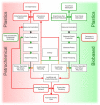Are Biobased Plastics Green Alternatives?-A Critical Review
- PMID: 34360022
- PMCID: PMC8345407
- DOI: 10.3390/ijerph18157729
Are Biobased Plastics Green Alternatives?-A Critical Review
Abstract
Environmental sustainability is driving an intense search for "green materials". Biobased plastics have emerged as a promising alternative. Their building blocks can now be obtained from diverse biomass, by-products, and organic residues due to the advances in biorefineries and bioprocessing technologies, decreasing the demand for fossil fuel resources and carbon footprint. Novel biobased polymers with high added value and improved properties and functionalities have been developed to apply diverse economic sectors. However, the real opportunities and risks of such novel biobased plastic solutions have raised scientific and public awareness. This paper provides a critical review on the recent advances in biobased polymers chemistry and emerging (bio)technologies that underpin their production and discusses the potential for biodegradation, recycling, environmental safety, and toxicity of these biobased solutions.
Keywords: biodegradation; bioplastics; circular economy; plastic pollution; sustainability.
Conflict of interest statement
The authors declare that they have no known competing financial interest or personal relationships that could have influenced the work reported in this paper.
Figures


References
-
- Meikle J. American Plastic: A Cultural History. Rutgers University Press; Brunwick, NJ, USA: 1995.
-
- Lebreton L., Andrady A. Future scenarios of global plastic waste generation and disposal. Palgrave Commun. 2019;5:6. doi: 10.1057/s41599-018-0212-7. - DOI
-
- Ncube L.K., Ude A.U., Ogunmuyiwa E.N., Zulkifli R., Beas I.N. An overview of plastic waste generation and management in food packaging industries. Recycling. 2021;6:12. doi: 10.3390/recycling6010012. - DOI
-
- Plastics—The Facts 2020. [(accessed on 9 July 2021)]; Available online: https://www.plasticseurope.org/en/resources/publications/4312-plastics-f....
Publication types
MeSH terms
Substances
LinkOut - more resources
Full Text Sources

